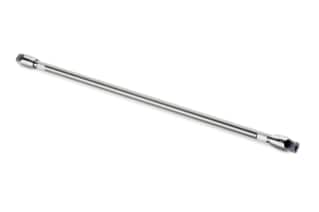GTxResolve Slalom Columns
Accelerate bioprocessing and release testing of gene therapy drug substances and products
Achieving high-resolution, sensitive, and fast nucleic acid and plasmid DNA LC-based analyses can be challenging, and separating double-stranded linear nucleic acids can be a slow process. Scientists working in analytical process development can now benefit from high-sensitivity, high-resolution, fast, reproducible, and low-adsorption Waters GTxResolve Slalom Columns for double-stranded RNA (dsRNA) impurity, restriction enzyme mapping, and plasmid DNA profiling. Batch-tested and QC-certified, PEO-BEH 250Å slalom particles support reproducible and robust analytical method development—with the ability to separate double-stranded linear nucleic acids in less than five minutes.
Powered by innovative and patented column packing technology, slalom chromatography delivers industry-leading resolution, speed, and sensitivity, essential for characterizing critical quality attributes with confidence. Paired with advanced analytical methods and MaxPeak Premier HPS Technology, this solution minimizes non-specific adsorption, enhancing sensitivity, reproducibility, and overall productivity in your lab.
Specifications
Overview
- Enhanced resolution of large nucleic acids better than gels in < 5 min
- Robust methods for accurate quantitation of dsRNA impurities in mRNA
- Low-adsorption hardware minimizes non-specific interactions, ensuring high recovery and reproducibility
- UPLC speeds for when throughput matters most
Recommended Use: For separation of double stranded linear nucleic acids.
GTxResolve Slalom Column Characteristics
-
2.5–25 Kbp nucleic acids
-
2.5 µm BEH-PEO particle
-
MaxPeak HPS hardware
-
30 mm Guard Column Available
-
Waters dsDNA 23k ladder
-
Ideal for performance and system suitability testing
-
Bundled with column for troubleshooting
Gel-like separations. UPLC speeds.
Understanding plasmid identity, purity, and structural forms is critical for large-scale recombinant protein production and in vitro transcription (IVT) of mRNA. Traditionally, plasmids digested with a restriction enzyme are analyzed by agarose gel electrophoresis, a workflow that can be labor-intensive, time-consuming, and offers limited resolution. Slalom chromatography provides a rapid restriction enzyme map, enabling analysis of large digestion products in under five minutes per injection. This new separation provides a gel-like profile that is used for restriction mapping for identity confirmation of DNA samples. Utilizing an LC platform also enables fraction collection for further characterization of digested products as an alternative to excising gel bands.
dsRNA impurity analysis
dsRNA is a critical impurity generated during IVT synthesis of mRNA drug-based therapeutics and vaccines. This unwanted byproduct can trigger potent immune responses, leading to reduced therapeutic efficacy and compromised patient safety. Accurate quantification of dsRNA impurities is essential to meet regulatory compliance and ensure product safety. This application demonstrates the Waters GTxResolve Slalom Column, MaxPeak Premier 2.5 µm, providing high resolution and sensitivity of dsRNA by exploiting variations in relaxation times within a controlled shear field.
Plasmid topology
Plasmid DNA (pDNA) is a fundamental component in many biotherapeutics, including gene therapies and mRNA vaccines. Plasmid preparations often contain multiple isoforms, including supercoiled, open circular, and linear forms. The presence of circular plasmids is undesirable for IVT due to readthrough transcription and aberrant transcript generation.
Each isoform has distinct biological properties; therefore, accurate separation and characterization are critical to ensure the quality, integrity, and consistency of the IVT process, as well as drug safety and efficacy. This application demonstrates high-resolution, fast, and accurate separation of plasmid isoforms using the Waters GTxResolve 250 Å Slalom Column, MaxPeak Premier 2.5 µm.
What customers are saying…
"Replicate Bioscience has been evaluating the potential of slalom chromatography to analyze 15.5 kilobase (kb) self-replicating RNA. Preliminary data indicates that this new analytical tool will be a fast and efficient orthogonal approach to capillary gel electrophoresis, and the team at Replicate is eager to continue its development."
Andrew Geall, Chief Development Officer and Co-Founder, Replicate Bioscience
Resources
Documents
- Retention mechanism in combined hydrodynamic and slalom chromatography for analyzing large nucleic acid biopolymers relevant to cell and gene therapies
- Ultra-high pressure slalom chromatography: Application to the characterization of large DNA and RNA samples relevant in cell and gene therapy
- Theoretical predictions to facilitate the method development in slalom chromatography for the separation of large DNA molecules
- Retention mechanism in slalom chromatography: Perspectives on the characterization of large DNA and RNA biopolymers in cell and gene therapy
